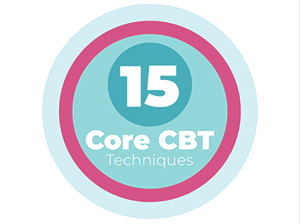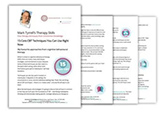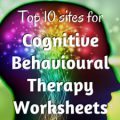
When it comes to cognitive behavioural therapy (CBT), there are many, many techniques, skills, strategies, and interventions at your disposal. Some of these techniques are best used in a therapist-client setting, while others lend themselves quite well to individual or ‘self-help’ situations.
Techniques can also be used in tandem or individually. It depends on the setting, the circumstance or issue, and the individual seeking help. That’s the cool thing about CBT techniques – there is no ‘cookie cutter’, one-size-fits-all way to use them.
What the techniques, skills and strategies I’m going to discuss here all have in common is that they are built upon the foundations of CBT – identifying maladaptive thinking and intentionally making specific, strategic behavioural interventions to achieve a desired outcome. Some are general CBT techniques, while others are more targeted to specific issues or needs.
Let’s start with the basics that form the foundation of CBT.
Behavioural experiments
![]()
Behavioural experiments are the cornerstone of CBT. These experiments are designed to test thinking and identify thought patterns that influence behaviour.
By intentionally ‘trying out’ specific ways of thinking and observing the outcome behaviours, clients gain a deeper awareness of the patterns of thinking that may be holding them back from reaching their goals.1
Thought records
![]()
Thought records are also designed to test the validity of our thoughts. Deliberately recording our thoughts provides a way for us to evaluate the evidence for or against a particular way of thinking – essentially, is it true or not true based on the situation? Thought records help the client to establish a more balanced way of thinking based on logic – what is as opposed to what they feel.1,2
Behavioural activation (aka scheduling pleasant activities)
![]()
This strategy is at once so simple yet so powerful. Pleasurable activities are among the first to go when people are faced with adversity. Intentionally taking part in activities that are enjoyable helps to reduce negative thinking and promotes more positive emotions and feelings of wellbeing. Behavioural activation is particularly helpful for clients with depression.3
Exposure
![]()
Exposure is a powerful intervention used to help clients face their fears or phobias in a controlled way. Basically, you’re asking the client to be exposed to the very thing they fear. It will, of course, be scary for them.
When used properly, exposure has been proven to be effective in the reduction of fears and phobias. Exposure techniques are best utilized as part of a therapeutic intervention with a therapist who is well trained in their use.
There are many exposure techniques, and even more ways to implement them.4 Here are some of the more common and well known techniques.
- Situation exposure hierarchies
In this technique, the therapist helps the client make a list of feared objects or situations. The client then rates, on a scale of 0 to 10, how distressed they would be by each item. For example, a person who fears dogs might say “Not seeing a dog in the yard” is 0. “A dog licking my hand” might be their 10.
Starting with the least distressing, the therapist helps the client work through each situation in the list. This is a way of gradually increasing exposure and diminishing the distress of exposure.
- Flooding
Flooding also uses exposure hierarchies, but generally begins with the more difficult or distressing scenarios or objects. Caution should be used when choosing this technique, as it can elicit strong responses. This technique is best utilized as part of a therapeutic intervention.
- Systematic desensitization
This technique involves combining exposure with relaxation exercises. The client is taught strategies to remain relaxed in situations that would normally elicit fear. Gradually, they start to associate their feared object or situation with relaxation rather than powerful negative feelings.
However, in general, the approach we favour at Uncommon Knowledge for phobias and PTSD is the Rewind Technique as it is fast, comfortable, effective and non-voyeuristic.
Journaling
![]()
Journaling is a great way to gather information about thoughts and feelings. The journal can be used as a place to identify, describe, and evaluate moods, thoughts, scenarios, and responses. Having a place to ‘unpack’ and explore can lead to tremendous insight.
Cognitive restructuring – unravelling cognitive distortions
![]()
Cognitive distortions are patterns of faulty thinking that convince us something is true when it is not. There are several types of cognitive distortions. To unravel them, the client must learn which are present for them and how to challenge those ways of thinking.
We have a worksheet that can help clients challenge their distortions in thinking and one for cognitive restructuring. This can also be accomplished through the therapist-client dialogue. The goal, of course, is to help the client learn to do this on their own.1
Here are five ‘thought challenges’ from the NHS Fife Department of Psychology’s Negative Thinking CBT Tools.5 You can use these to get your client to take a closer look at their negative thought patterns.
1. What are the chances…?
The things you worry about may be very unlikely to happen. Would you be willing to put money on it happening?
2. What is the worst thing…?
The things you worry about might happen, but you’re making way too much of them. Consider whether it would really be that bad if the worst did happen, and realize that it might not be worth all that anxiety.
3. Am I right to think that…?
You might be missing important information that would help you with decisions. As you gather more information, your worry and stress may abate.
4. The five year rule (‘the history game’)
This challenge has been applied to lots of situations within and outside of CBT to put events that have happened or will happen into perspective. Ask yourself, “Five years from now, will it really matter?”
5. What is this worth?
Consider just how important this thing you’re worrying about is. Life is too short to be spent worrying about things that just don’t deserve that kind of time investment.
You may also find helpful my free Cognitive Distortions Worksheet.
Functional assessment (ABCs)
![]()
A functional assessment tool allows the client to record the ABCs (antecedents, behaviours, consequences) of a situation. This data allows the therapist and client to begin to identify patterns of behaviour.3 There are plenty of these forms on the Internet, but it’s also super easy to design your own.
Reframing
![]()
It’s easy to fall into familiar patterns of negative thinking. One way to counteract negative thinking is through reframing. Reframing is the act of changing the meaning attributed to something so that the thought or experience of it no longer causes emotional problems.
Reframing disrupts the negative cycle of perpetuation and resets the focus on something positive.1 This technique can be used both in sessions and as part of homework, using a thought record or similar tool.
Homework

Homework is an essential part of the CBT process. Homework assignments help clients learn new skills and integrate the concepts learned in sessions into daily life, improving treatment compliance and contributing to symptom reduction.1,3
Relaxation and mindfulness
![]()
Four of my favourite relaxation and mindfulness practices are progressive muscle relaxation (PMR), meditation, deep breathing and self hypnosis. Each is a bit different in its implementation and intent.
- PMR involves the systematic tensing and releasing of each muscle group, combined with deep breathing and mental imagery.
- Mindfulness meditation involves clearing the mind and focusing on the sensations and thoughts in the moment, observing them and allowing them to pass.
- Deep breathing is an action that is physiologically incompatible with anxiety.
- Self hypnosis can be easily achieved by listening to audio hypnosis sessions and can calm the mind quickly.
Relaxation and mindfulness skills give the client a new and different way to respond to distressing situations. This change of response can break the cycle of perpetuation. Relaxation also helps the client to quiet their mind so that they can think more rationally and logically. YouTube videos, audio recordings, apps, and even relaxing music can all be good resources here.
The SOLVED technique
![]()
This technique is used to teach the client problem-solving skills.3 While there are many variations on this technique (and lots of other names for it), structured problem solving is a critical skill for clients to learn. The acronym SOLVED gives the client a tangible, memorable tool for working through the problem-solving steps.
S – Select a problem that the client wants to solve.
O – Open your mind to all solutions – brainstorm all the options with your client.
L – List the potential pros and cons of each potential solution.
V – Verify the best solution – decide which choices are practical or desirable.
E – Enact the plan.
D – Decide if the plan worked.
Role play
![]()
Role play has a significant place in CBT. It can be used to help clients discover automatic thoughts, practise new responses, or modify core beliefs. Role play is also a useful tool for learning new social skills such as assertiveness.1
The ‘pie’ technique
![]()
Based on the simple pie chart, the ‘pie’ technique lets clients see their goals and ideas in graph form. The ‘pie’ technique can help with things like setting goals and determining responsibility for outcomes.1
Simply have the client place each idea or goal into a pie chart, divided according to importance as they see fit. This process can be done as part of a homework assignment or as part of the ongoing therapist-client dialogue. Beck (2011) has several illustrations and examples of the use of this technique.1
Credit list technique
![]()
This is a simple technique that can yield powerful results. Clients coming to therapy often lack confidence in their ability to change and may not immediately recognize the positive steps they are taking. The credit list is simply a daily list that the client makes of positive things he or she deserves credit for.
Not only does this technique help the client to recognize their progress, it also strengthens their ability to identify underlying positive beliefs and qualities when doing their core beliefs work in therapy.1
Letting the story play out
![]()
This technique is a sort of thought experiment. The therapist asks the client to imagine the outcome of their worst-case scenario, then encourages them to let the scene play out to its conclusion. Allowing the worrisome event to play out allows the client to see that even if their worst fear should come to pass, things can and do pass and get better.2
So there you have it. A whole set of tools you can add to your CBT toolbox. While you are probably familiar with many of these tools, some might be new to you. As always, be sure you are working within your scope of practice. If you feel unsure about some of these techniques, seek out additional training specifically in CBT.
Watch Mark reduce a client’s stress and increase their exercise motivation in Uncommon Practitioners’ TV
This is this client’s fifth session and although she has lost plenty of weight and got fitter and healthier, she feels she has reached a plateau. She has also been feeling particularly stressed recently due to high work demands, her father, and the need to be supportive to her daughter.
She feels her diet is pretty balanced but that she needs to move more. She feels fine about cycling now but feels she hasn’t been doing enough.
Mark describes the benefits of short but really intense exercise and she agrees she can start with three lots of 30 second sprints on her stationary bike a week.
Mark utilizes the pleasure the client got from a recent holiday with her daughter as the basis for a hypnotic induction and suggests she can feel more motivated to get up to a new level – “find a better plateau” and also feel less stressed day to day.
Members of Uncommon Practitioners TV can watch this session online now. And if you’d like to join, you can sign up to be notified when booking is open here.
Notes:
(1) Beck, J. (2011). Cognitive behavior therapy: Basics and beyond (2nd ed.). New York, NY: The Guilford Press.
(2) https://positivepsychologyprogram.com/cbt-cognitive-behavioral-therapy-techniques-worksheets/
(3) https://www.mirecc.va.gov/visn16/docs/therapists_guide_to_brief_cbtmanual.pdf
(4) http://www.div12.org/sites/default/files/WhatIsExposureTherapy.pdf
(5) https://www.moodcafe.co.uk/media/19118/Negative%20Thinking.pdf










